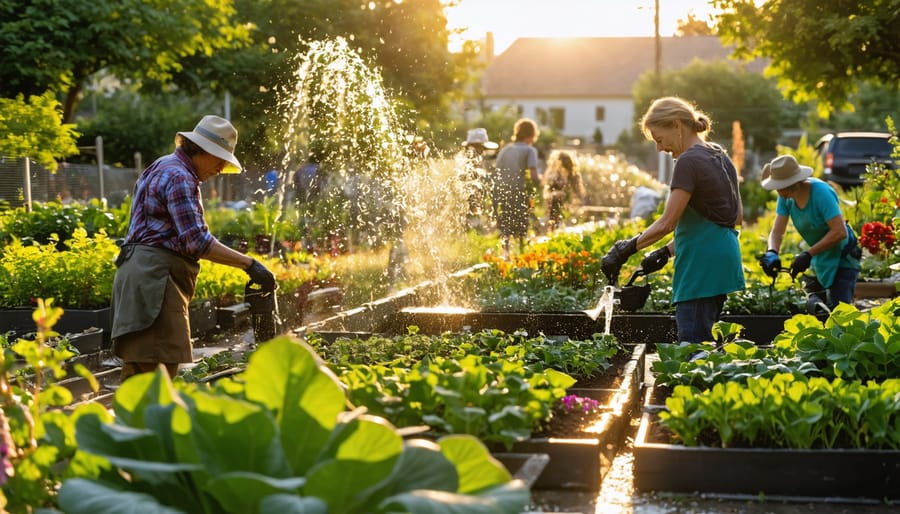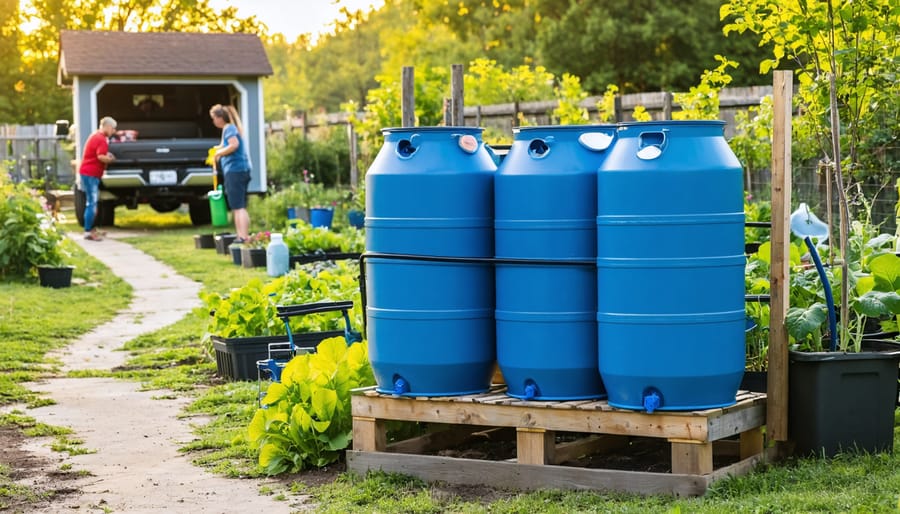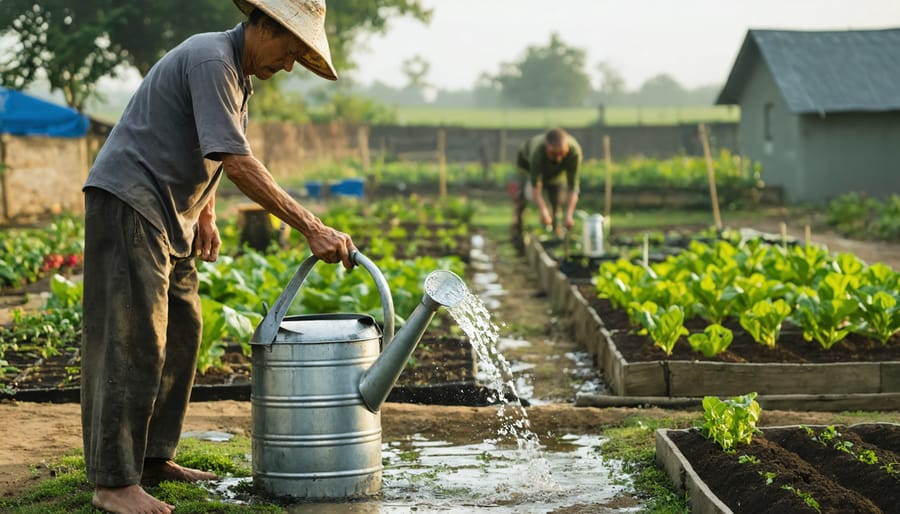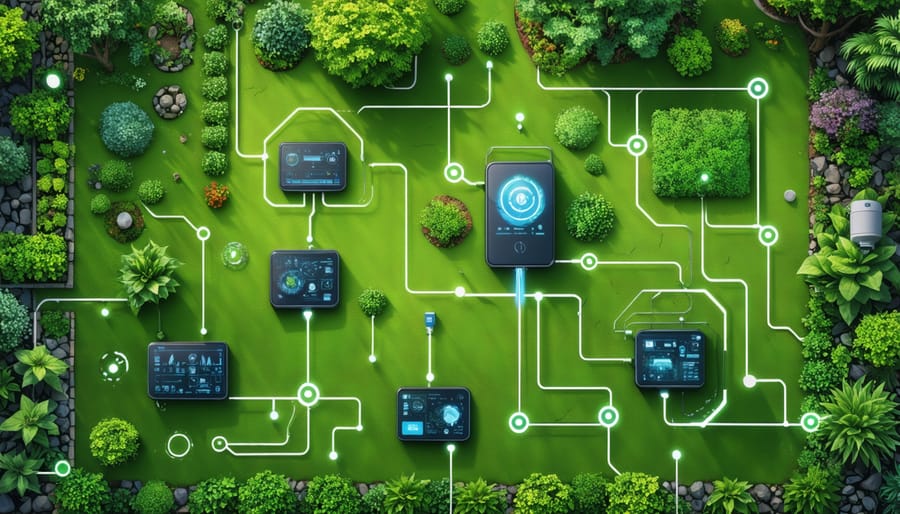Transform your community’s water future by taking control of local resources today. Smart water management at the neighborhood level not only reduces costs but creates lasting environmental impact through collective action. When communities band together to oversee their water resources, they achieve remarkable results – from 30% reductions in water waste to thriving shared gardens and green spaces that enhance property values.
Our experience working with over 100 neighborhood associations shows that successful community water management starts with three key elements: a dedicated volunteer water committee, clear usage monitoring systems, and collaborative conservation goals. Small changes, implemented consistently across multiple households, create significant impact. Installing rain gardens, adopting efficient irrigation schedules, and maintaining shared infrastructure become powerful tools when coordinated at the community level.
Whether you’re dealing with drought conditions, rising utility costs, or simply want to become better stewards of local resources, community-based water management offers a proven framework for success. This guide will walk you through establishing an effective program that engages residents, measures outcomes, and creates lasting positive change for your neighborhood’s water future.
Building Your Community Water Management Team
Finding Your Water Warriors
Every successful community water management project needs dedicated people with diverse skills. Start by looking for neighbors who already show interest in gardening or environmental issues – they’re often eager to get involved! Connect with local master gardeners, retired landscapers, or environmental professionals who can bring valuable expertise to your team.
Don’t overlook the power of social media and community bulletin boards to find potential water warriors. Create engaging posts about your initiative and watch as interested community members come forward. Local gardening clubs, environmental groups, and neighborhood associations are excellent places to recruit passionate volunteers.
Remember to seek out people with different strengths. While gardening knowledge is valuable, you’ll also benefit from having organized planners, social media savvy individuals, and those with grant writing experience. Even residents who simply enjoy taking photos or managing spreadsheets can contribute meaningfully to your water management efforts.
The key is to make everyone feel welcome and valued, regardless of their experience level. Sometimes the most enthusiastic water warriors are complete beginners who bring fresh perspectives and energy to the project.

Setting Clear Goals Together
Setting clear goals is the foundation of successful community water management, and it works best when everyone has a voice in the process. Start by organizing a community meeting where all stakeholders can share their concerns and ideas. Whether it’s reducing water usage by 20% or creating a drought-resistant community garden, goals should be specific and measurable.
Break down larger objectives into smaller, achievable milestones. For example, you might start with a three-month goal to audit current water usage, followed by implementing simple conservation methods like mulching community garden beds or installing rain barrels at key locations.
Make sure to document these goals and create a timeline that works for everyone. Consider seasonal changes and local weather patterns when planning. It’s helpful to assign “water stewards” who can monitor progress and keep the community motivated.
Remember to celebrate small wins along the way! When neighbors see positive results, like lower water bills or thriving gardens using less water, they’re more likely to stay committed to the program. Regular check-ins and adjustments keep everyone aligned and moving toward those shared water management goals.
Smart Water Conservation Strategies That Work
Rainwater Harvesting Systems
Community rainwater harvesting offers an excellent opportunity to maximize water efficiency while fostering neighborhood cooperation. Installing a shared rainwater collection system can significantly reduce your community’s reliance on municipal water supplies, especially during the growing season.
Start by identifying suitable collection points, such as community center roofs, shared gazebos, or other common structures. Large surface areas work best, as they capture more rainfall. Consider installing multiple collection tanks strategically placed throughout the neighborhood to ensure fair distribution.
The basic setup includes gutters, downspouts, first-flush diverters, and storage tanks. First-flush diverters are particularly important as they filter out initial roof runoff, which often contains debris and contaminants. Storage tanks should be properly sized based on your community’s needs and local rainfall patterns.
Distribution can be managed through a simple scheduling system, where residents sign up for specific time slots to access the collected water. Many communities find success with a points-based system, where participants earn credits through volunteer work or system maintenance.
Regular maintenance is essential and can become a community-building activity. Monthly cleanup days, where neighbors gather to clear gutters, check filters, and inspect equipment, help ensure system efficiency while strengthening social bonds. Remember to test water quality regularly and keep detailed records of collection and usage patterns to help optimize the system over time.
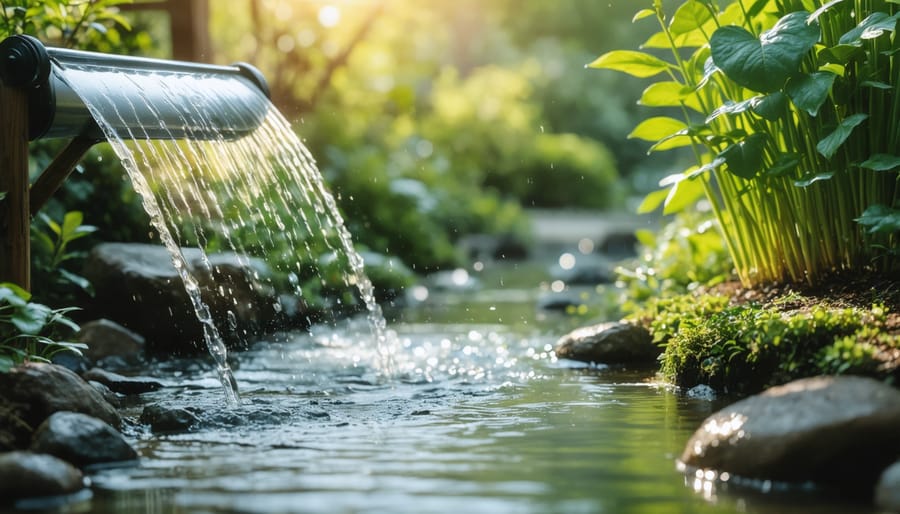
Gray Water Solutions
Gray water recycling offers an innovative solution for community gardens, turning household water from sinks, showers, and washing machines into a valuable resource. By implementing proper greywater recycling solutions, communities can significantly reduce their freshwater consumption while maintaining thriving garden spaces.
To get started, establish a simple collection system using food-safe storage containers and proper filtration. Basic filters can remove soap residues and particles, making the water safe for plant use. Remember to use plant-friendly, biodegradable soaps and cleaning products in your homes to ensure the gray water remains garden-safe.
Installing a basic irrigation system with perforated pipes or soaker hoses helps distribute gray water evenly throughout the garden. This method works particularly well for fruit trees, ornamental plants, and larger vegetables. However, avoid using gray water on root vegetables or leafy greens that are eaten raw.
Many community gardens have found success with mulch basins – shallow depressions filled with organic matter that help filter and distribute gray water while preventing direct contact with plants. This approach not only conserves water but also enriches the soil as the organic matter breaks down.
Regular monitoring of soil health and plant response ensures the system works effectively. Consider organizing workshops to teach community members about proper gray water use and maintenance, creating a knowledgeable and engaged group of garden stewards.
Smart Irrigation Planning
Creating a smart irrigation plan for your community garden starts with understanding your local climate and coordinating with fellow gardeners. The key is to establish watering schedules that maximize efficiency while minimizing waste. Consider dividing your garden into hydrozones – areas grouped by water needs – to ensure each plant receives exactly what it needs without overwatering others.
Installing efficient irrigation systems is a game-changer for community gardens. Modern options include drip irrigation, soil moisture sensors, and weather-based controllers that automatically adjust watering schedules based on local conditions. These systems can reduce water usage by up to 50% compared to traditional sprinklers!
Work with your community to create a watering schedule that accounts for everyone’s availability. Morning hours are ideal for irrigation, as less water is lost to evaporation. Consider appointing “water stewards” who can monitor and adjust the system as needed. They can ensure proper maintenance and quick response to any issues that arise.
Don’t forget to mulch! A 2-3 inch layer of organic mulch helps retain moisture and reduces water needs significantly. Combined with proper timing and technology, mulching creates a water-wise environment that benefits both your garden and your community’s water conservation goals.
Regular system checks and seasonal adjustments ensure your irrigation plan remains effective year-round. Remember, successful community water management is about working together and staying flexible as conditions change.
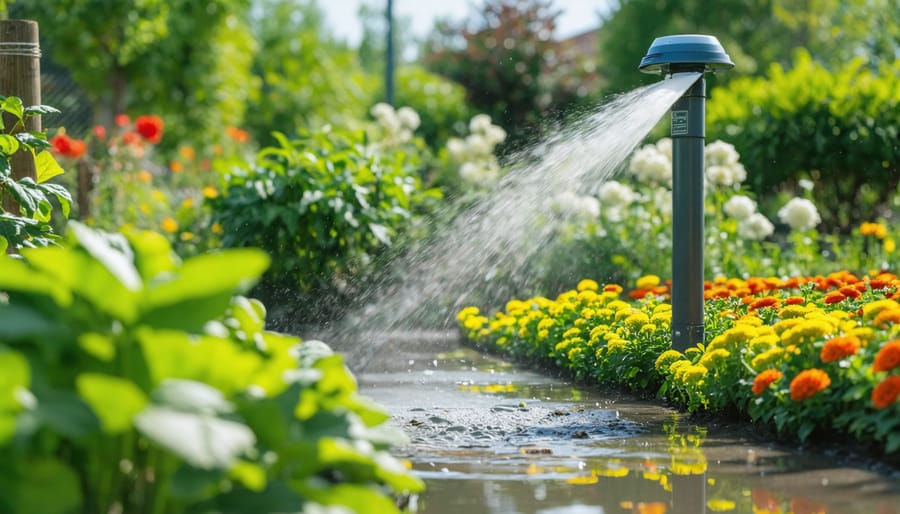
Making Your Water Program Last
Creating Clear Guidelines
Creating clear guidelines for community water usage doesn’t have to be complicated. Start by gathering your neighbors for a friendly discussion about water needs and concerns. Together, you can develop a set of straightforward protocols that everyone can follow and understand.
Begin with documenting basic watering schedules – for instance, establishing specific days for different areas or types of plants. Consider creating a simple calendar system where community members can sign up for watering duties and track usage. This helps prevent overwatering and ensures every area gets the attention it needs.
Include specific guidelines for different seasons and weather conditions. For example, during summer months, early morning or evening watering helps reduce evaporation, while winter might require less frequent watering. Make sure to outline emergency protocols for drought conditions or water restrictions.
Document everything in a clear, easy-to-read format. A simple handbook or digital document works well, with sections for general rules, schedules, and maintenance procedures. Include visual guides when possible – pictures of proper sprinkler placement or diagrams showing optimal watering patterns can be incredibly helpful.
Keep your guidelines flexible enough to accommodate different gardening styles while maintaining consistent water conservation principles. Regular reviews and updates ensure your protocols remain relevant and effective as your community’s needs evolve.
Monitoring and Adjusting
Success in community water management relies heavily on regular assessment and adaptation. Setting up a system for monitoring water usage helps track progress and identify areas that need improvement. Start by establishing baseline measurements for your community’s water consumption and create simple spreadsheets or use water monitoring apps to record weekly or monthly usage.
Regular check-ins with community members can provide valuable feedback about the effectiveness of your water conservation strategies. Consider organizing quarterly meetings where residents can share their experiences and suggestions. This collaborative approach helps maintain engagement and ensures everyone’s voice is heard.
Keep an eye on seasonal changes and weather patterns, as these significantly impact water needs. During particularly dry spells, you might need to adjust watering schedules or implement additional conservation measures. Similarly, after heavy rains, you may want to reduce irrigation temporarily.
Don’t be afraid to make adjustments when something isn’t working as planned. If certain plants are struggling despite following the initial watering schedule, modify your approach. Remember that successful water management is an evolving process – what works in spring might need tweaking for summer conditions.
Document both successes and challenges, and share these insights with your community. This transparency helps maintain trust and encourages continued participation in your water conservation efforts.
Celebrating Success
Celebrating your community’s water management achievements is essential for maintaining momentum and inspiring others to join the cause. Consider organizing seasonal garden tours where participants can showcase their water-efficient landscapes and share their success stories. These events not only build community pride but also provide valuable learning opportunities for newcomers.
Document and share your progress through before-and-after photos, water usage statistics, and testimonials from participating households. Create a community newsletter or social media group where members can post their achievements, such as reduced water bills or thriving drought-resistant gardens. These visual records help demonstrate the tangible benefits of your collective efforts.
Recognize individual contributions by establishing an annual “Water Wise Garden” award or hosting a harvest festival that highlights sustainable gardening practices. Consider partnering with local businesses to offer small prizes or recognition for outstanding water conservation efforts.
Don’t forget to celebrate the small wins too! Whether it’s successfully installing a rain garden or reducing community water usage by 10%, each milestone deserves recognition. Host regular community gatherings where members can share tips, exchange plants, and discuss future goals over refreshments.
Remember to involve local schools and youth groups in your celebrations. Children’s artwork displays, student-led presentations, or school garden competitions can help ensure the next generation embraces water-conscious gardening practices.
As we’ve explored throughout this article, community water management is not just about conservation – it’s about bringing people together to create lasting, positive change in our neighborhoods. By implementing the strategies we’ve discussed, from rainwater harvesting to drought-resistant landscaping, communities can significantly reduce their water consumption while creating beautiful, sustainable spaces for everyone to enjoy.
Remember, successful water management starts with small steps. Whether you’re organizing a neighborhood meeting to discuss water-saving initiatives or simply sharing your knowledge about efficient irrigation techniques with your neighbors, every action counts. The key is to start somewhere and build momentum gradually.
Consider forming a community garden committee or joining your local environmental advisory board. These platforms can help you connect with like-minded individuals and access resources to support your water conservation efforts. Many communities have found that starting with a single demonstration garden or rain barrel workshop can spark widespread interest and participation.
Don’t be discouraged if you face initial resistance or challenges. Change takes time, and building community support is an ongoing process. Focus on educating others about the benefits of water conservation, both environmental and financial. Share success stories from other communities and emphasize how these initiatives can increase property values and create more resilient neighborhoods.
Take action today by reaching out to your local government representatives about water conservation programs or organizing a community meeting to discuss water-saving strategies. Start a social media group to share tips and progress updates, or volunteer to help elderly neighbors install water-efficient irrigation systems.
Together, we can create more sustainable communities where water is valued and managed wisely. Your involvement, no matter how small it may seem, contributes to a larger movement toward responsible water stewardship. Let’s work together to protect this precious resource for current and future generations.

